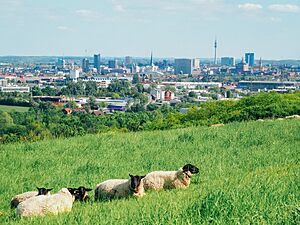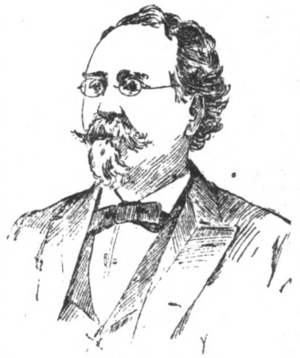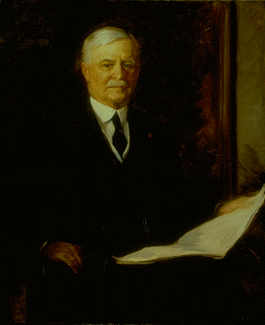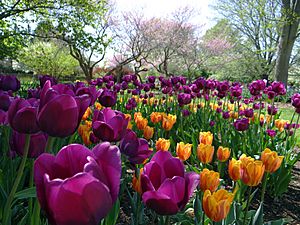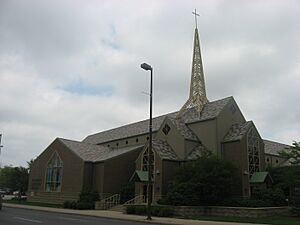Henry C. Berghoff facts for kids
Quick facts for kids
Henry C. Berghoff
|
|
|---|---|
 |
|
| 19th Mayor of Fort Wayne | |
| In office May 9, 1901 – January 1, 1906 |
|
| Preceded by | Henry P. Scherer |
| Succeeded by | William J. Hosey |
| Personal details | |
| Born | January 6, 1856 Dortmund, Kingdom of Prussia |
| Died | June 28, 1925 (aged 69) Fort Wayne, Indiana, U.S. |
| Citizenship | American |
| Political party | Democratic |
| Spouse | Theresa Mayer Berghoff (m. 1877) |
| Children | 9 |
| Occupation | Politician, lawyer, businessman |
Henry Carl Berghoff (January 6, 1856 – June 28, 1925) was an American politician, lawyer, and businessman. He helped start the Herman Berghoff Brewing Company. He also served as the 19th Mayor of Fort Wayne, Indiana from May 9, 1901, to January 1, 1906.
Berghoff was born in Dortmund, Germany, and moved to the United States in 1872. He settled in Fort Wayne, Indiana. With his brothers, he started the Herman Berghoff Brewing Company in 1887. They opened their first brewery in Fort Wayne in 1888. Henry Berghoff was involved in many local businesses. He also became active in local Democratic politics in Fort Wayne. He held various local political jobs from 1885 to 1901.
In 1901, Berghoff was chosen by the Democratic Party to run for mayor of Fort Wayne. Some opponents criticized his German background during the campaign. But he was elected and took office on May 9, 1901. As mayor, Berghoff gave a speech praising German contributions to America. He also oversaw the opening of Fort Wayne's first electric interurban railroad in 1901. The new Allen County Courthouse was finished in 1902 during his time. He also saw the completion of the South Wayne Sewer in 1902.
There was a typhoid fever outbreak from 1903 to 1904. Berghoff signed an order that gave a city contract to the Fort Wayne Electric Light and Power company. In 1905, he appointed the first Fort Wayne Board of Parks Commissioners. Berghoff also started the German-American National Bank in 1905. It was later renamed Lincoln National Bank. This happened because of anti-German feelings during World War I. Berghoff ran for City Councilman-at-large in late 1905 but lost. He left office on January 1, 1906. He was the only mayor of Fort Wayne to serve a four-and-a-half-year term. After being mayor, Berghoff returned to his brewery and other businesses. He passed away on June 28, 1925, in Fort Wayne.
| Top - 0-9 A B C D E F G H I J K L M N O P Q R S T U V W X Y Z |
Early Life
Henry Carl Berghoff was born on January 6, 1856. His birthplace was Dortmund, Germany, which was then part of Prussia. His parents were Franz Anton and Lizette Berghoff. Henry had five brothers and one sister. In Dortmund, Henry went to high school. He also worked at a bank in Cologne, Germany.
In 1872, Henry moved to the United States. He decided to live in Fort Wayne, Indiana. He supposedly chose Fort Wayne after being offered a job there. This happened when his train stopped in the city. For a few years, he worked as a clerk and bookkeeper. He also studied law. In 1877, Henry married Theresa Mayer.
Business and Political Career
Business Ventures

In 1883, Henry and his brother Herman bought a bottling company in Fort Wayne. In 1887, Henry and three of his brothers started the Herman Berghoff Brewing Company. Henry worked as secretary, vice president, and treasurer for the company. They sold beer called "Berghoff’s Beer."
In 1888, the brothers opened their first Berghoff Brewery in Fort Wayne. On August 22, the brewery caught fire. It caused $50,000 in damages. But brewing started again just one month later. In 1892, Henry's brother Gustav bought another bottling company. Henry became its vice president. In 1898, Herman opened a restaurant called The Berghoff in Chicago. It is still open today and serves Berghoff's Beer. Around this time, the brewing company's name changed to "Berghoff Brewing Company."
Henry also partnered with the Artificial Ice Company. He owned Globe Spice Mills. He was also the treasurer of Phoenix Building and Savings Union.
Early Political Roles
Berghoff was a Democrat. He served as the treasurer of Fort Wayne for three terms. This was from 1885 to 1891. In 1890, he ran for Indiana State Treasurer but lost.
In 1893, Fort Wayne railway workers went on strike. They wanted higher pay. The workers started to cause disturbances. The sheriff asked several citizens, including Henry Berghoff, to help. Berghoff spoke at a meeting about how to handle the situation. The disturbances ended that day when the workers' demands were met. Berghoff returned to politics in 1896. He served as comptroller of Fort Wayne for two terms until 1901.
1901 Fort Wayne Mayoral Election
In April 1901, Berghoff became the Democratic candidate for mayor of Fort Wayne. The other candidates were Charles Reese (Republican) and Martin H. Wefel (Socialist). The election was very competitive. At that time, some Americans had negative views toward Germany. So, some Fort Wayne Republicans criticized Berghoff for being German. Democrats accused them of being unfair. Despite this, Berghoff won the election on May 7, 1901. He received 5,176 out of 9,209 votes. He was sworn in two days later.
Mayor of Fort Wayne
Starting His Term in 1901
Berghoff became mayor after Henry P. Scherer. He served from May 9, 1901, to January 1, 1906. Each year, Mayor Berghoff and other city officials wrote reports. These reports told the Fort Wayne Common Council about the city's finances. Right after becoming mayor, Berghoff appointed new city officials. He chose W. H. Shambaugh as city attorney. Joseph Fox became comptroller. Peter Eggeman, William Doehrmann, and Henry C. Zollinger joined the Board of Public Works.
1901 Indiana District Turnfest
On June 15, 1901, Fort Wayne hosted the Indiana District Turnfest. This was a German gymnastic festival held every two years. Over 3,000 people attended from different states. Mayor Berghoff gave an inspiring speech at the event. He praised Germans for their contributions to America. He said Germans had done more for the country's progress than any other people. Berghoff was proud to be German. He encouraged the audience, "we Germans in America," to remember their heritage. He believed that most Fort Wayne citizens were German. The event was very successful. Berghoff showed that he could be a successful leader while still honoring his German background.
Solving a Water Problem in 1901
In July 1901, Fort Wayne faced a possible water shortage. A fire had destroyed the city's water reservoir. Mayor Berghoff worked with experts and local business people. They decided to increase the city's water pumping ability. They installed new equipment at two water plants. Berghoff also ordered water from a canal basin to flow into the city's main supply for ten hours. This helped provide more water.
These changes were meant to supply the city with enough water for many years. However, the water from the canal basin polluted the city's water. Berghoff accepted the blame for the pollution. He argued that preventing a water shortage was necessary. He also suggested using water meters to reduce wasted water. He thought this would lower water costs for citizens.
In September 1901, a big event happened. The first electric interurban railway opened in Fort Wayne. This railway, the Fort Wayne and Northern Indiana Traction Company line, helped make Fort Wayne an important center for travel and trade in the Midwest.
At the end of 1901, Berghoff praised the Fort Wayne Fire Department. He said it was "one of the best in the state." He also praised the Health Department. The death rate from contagious diseases was very low that year. He advised the Health Department to prepare for possible outbreaks of diseases like diphtheria and smallpox.
Court Case and Courthouse
In April 1902, the Indiana State Supreme Court made a ruling against Mayor Berghoff. Governor Winfield T. Durbin had appointed Robert B. Dreibelbiss as a judge. Berghoff believed the appointment was not right. So, he refused to approve Dreibelbiss's official bond. This stopped Dreibelbiss from becoming a judge. A lower court agreed with Berghoff. But the Indiana Supreme Court later said the governor's appointment was valid.

Berghoff also oversaw the completion of the Allen County Courthouse in Fort Wayne in 1902. The courthouse cost over $800,000 to build. Construction began in 1897, before Berghoff was mayor. The building has a Beaux-Arts style. It is made of steel, granite, and limestone. Inside, there is white marble and beautiful artwork. The courthouse has a large dome with stained glass windows. On top of the dome is a copper statue of the Goddess of Liberty.
On September 23, 1902, the courthouse was officially opened. Mayor Berghoff was there. Governor Winfield T. Durbin also attended. The courthouse was later added to the National Register of Historic Places in 1976. It became a National Historic Landmark in 2002.
Fort Wayne in 1902
During Berghoff's time as mayor in 1902, postal sub-stations were set up in Fort Wayne. These were located in drugstores. Also, the Fort Wayne Fair association was created that year.
Berghoff warned the Fort Wayne Gas Company in 1902. He said if they did not provide enough gas, the city might end their contract. He also noted that the Fort Wayne Fire Department spent less than its budget for the first time.
Berghoff worked to reduce crime and bad behavior in Fort Wayne. He ordered wine rooms removed from saloons. He also banned people of bad character from certain places. Gambling devices were removed from public areas.
He also talked about improving streetcar services. He wanted lower fares and better service. Berghoff also thought about the city having its own heating plant. He praised Fort Wayne's parks and wanted to improve them. He believed street improvements should happen when people asked for them. He wanted Fort Wayne to be a modern city. He also worked to improve the city's contagious disease hospital. He wanted a new hospital built.
City Sewers
Berghoff strongly supported the Intercepting Sewer in 1902. This sewer was started before he became mayor. It was built to follow Indiana sanitation laws. It helped clean the St. Mary's River. It moved sewage outside the city. Some people criticized the sewer, but Berghoff believed it was a great improvement. He said it made Fort Wayne much cleaner.
He also announced the completion of the South Wayne Sewer. This sewer also started before his term. It helped drainage in the southern parts of the city. Berghoff said it was "first-class in every respect." He believed these sewers greatly improved Fort Wayne's cleanliness.
Fort Wayne in 1903
In 1903, the Fort Wayne Rolling Mills were built. Two hundred fifty workers came from Chicago to work there. Berghoff stated that more public works were done in 1903 than ever before. This included new streets, sewers, and repaired bridges. He also said that Fort Wayne was "comparatively free from crime."
Typhoid Fever Outbreak

In November 1903, water in Fort Wayne became contaminated. Typhoid bacteria from the St. Marys River entered the water supply. This caused a typhoid fever outbreak. The City Health Commissioner, Dr. A. H. Macbeth, told the public in February 1904. There were over 80 new cases. Some blamed Republican waterworks officials. But a journalist pointed out that the health commissioner was responsible for water tests. Berghoff did not ask for Macbeth's resignation. On March 26, 1904, Berghoff announced the drinking water was safe again. He did not blame anyone for the outbreak.
City Lighting
For a long time, Berghoff wanted Fort Wayne to have its own lighting plant. This meant the city would own and run it. Many citizens also liked this idea. But in 1903, Berghoff changed his mind. He decided a private company should supply the city's lighting. He believed private companies could manage things better.
On February 12, 1904, Berghoff signed an order. This gave a 31-year contract to the Fort Wayne Electric Light and Power company. This was a private company. Some newspapers criticized his decision. They said he "broke faith with the people." Others praised it, saying it would be good for the city. The city later built its own lighting plant in 1906, after Berghoff's term ended.
Fort Wayne in 1904
On July 14, 1904, Berghoff spoke at a meeting of the Indiana State Bar Association. The association's president called him "the best mayor of the best city in America." In 1904, a short railway called the Lake Erie and Fort Wayne Belt Line Railway opened.
At the end of 1904, Berghoff looked back at his accomplishments. He said more public works were done in 1904 than ever before. This included new streets, sidewalks, and sewers. He also said that for the first time, no complaints were made against the Fort Wayne Fire Department.
He noted that cases of contagious diseases had dropped significantly. Berghoff again asked for a new contagious disease hospital. He said the current one was not good enough. Financially, Fort Wayne had saved money. Berghoff also told tax assessors to watch for tax evasion. He wanted taxes to be fair for everyone.
Fort Wayne in 1905

In 1905, Berghoff helped create the German-American National Bank. He worked there as head cashier. During World War I, it was renamed "Lincoln National Bank." This was due to anti-German feelings.
In February 1905, the Fort Wayne Clearing House was established. This helped financial institutions in the city.
In April 1905, Berghoff appointed the first Fort Wayne Board of Park Commissioners. Also in 1905, the Fort Wayne Hotel Company was started. Two new railroads, the Fort Wayne and Northwestern Traction Line and the Ohio Electric Traction Line, also opened. That same year, the Fort Wayne Natural Gas Company ran out of gas. Its service ended in November 1905.
Running for City Council
Berghoff decided not to run for mayor again in 1905. Instead, he sought a nomination for City Councilman-at-large. He received one of the nominations. However, he lost the general election on November 7, 1905.
Berghoff supported William J. Hosey for mayor. Hosey won the election. Mayor-elect Hosey wrote the annual mayor's report at the end of 1905. Berghoff left office on January 1, 1906. He warned Hosey that being mayor was not easy.
Later Life and Death
After being mayor, Berghoff left politics for good. He went back to working in business. He held positions at Wayne Oil Tank. He also continued as vice president of Summit City Bottle Works. This company was renamed "Rub-No-More Soap Company" in 1912. He also spent more time at the Berghoff Brewery.
In 1909, the Berghoff Brewing Company was reorganized. Its name changed to "Berghoff Brewing Association." On April 12, 1918, Prohibition began in Indiana. This stopped the production of Berghoff's Beer. The company was renamed "Berghoff Products." It started making "Brewers of Bergo Soft Drinks." Berghoff passed away on June 28, 1925, in Fort Wayne. He was 69 years old. He had suffered a stroke three days before.
Personal Life and Family
Henry Berghoff had silver hair styled in a unique way. He also had a distinguished mustache. He often ended his speeches by saying, "God Bless the brave founders of our state."
Berghoff was a Catholic. He was a member of St. Mary's Catholic Church. He also belonged to the Holy Name Society, the Knights of Columbus, and the Catholic Knights of America. Henry and his wife had nine children. His daughter, Elsie, married Edward C. Ehrman. Edward's father was a Fort Wayne City Councilman. Berghoff's son, Fred, was Chairman of the Fort Wayne Board of Public Safety. Another son, Raymond, served as the Allen County Coroner.
See also
- The Berghoff (Restaurant)
- List of mayors of Fort Wayne


